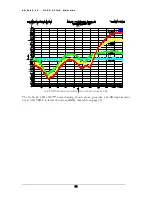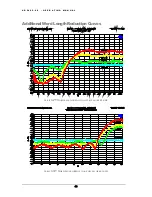
A D 2 4 0 2 - 9 6 - O P E R A T I N G M A N U A L
Will Dither Noise Damage My Speakers?
Please note that nothing bad happens when the gain of a playback system is increased
enough to hear dither noise. Dither will not blow out your speakers, unless possibly
someone inadvertently turns on an audio source while the amplifier is in this high gain state!
Remember that dither is an extremely low-level signal (much like tape hiss, only of a much
lower level).
How is the Performance of a Word Length Reduction System
Measured?
The audibility of dither can be expressed in terms of "F-Weighted Noise Power". The F-
weighting function is derived from measurements of the ear's sensitivity to very low level
signals. At 16-bits, 44.1-kHz the F-weighted noise power of TPDF dither is -93.3 dBFS and
the F-weighted noise power of NS3™ is -107.5 dBFS. In other words, 16-bit TPDF dither
provides a 93.3 dB noise-free dynamic range, while NS3™ provides a much greater 107.5 dB
noise-free dynamic range.
All word length reduction systems add noise to the audio, it is a law of mathematics.
However, the noise can be placed anywhere within the bandwidth of the digital system. If
the noise is evenly spread out over the entire bandwidth (as it is with TPDF dither), the
system will yield the lowest possible unweighted noise when measured on an audio analyzer.
But, a uniform noise distribution is not the best solution from an audibility standpoint. Our
ears are not equally sensitive to all frequencies within the 0 to 22.05 kHz bandwidth of a 44.1
kHz digital system. The audibility of the added noise is greatly reduced when it is
concentrated at frequencies where our ears are least sensitive. Near-Nyquist systems reduce
noise audibility by concentrating most of the noise energy between 18 kHz and the Nyquist
frequency (1/2 of the sample rate) while maintaining a relatively flat and natural sounding
noise floor below 16 kHz. Noise-Shaped systems attempt to achieve the greatest possible
noise improvement by distributing the noise in a function that is the inverse of the ear’s
sensitivity. TPDF will read the lowest on the meters, but will always sound louder than a
good word-length-reduction system. Don’t let the meters fool you! Remember, most
meters “hear” equally well at all frequencies.
Avoid Truncation without Dither:
There are numerous potential sources of noise within an A/D converter. These may include
thermal noise, noise from a delta sigma modulation process, cross talk, clock feed-through,
etc. None of these sources of noise are added intentionally, but in many cases these noise
sources may be of a high enough level to allow truncation without the addition of a dither
signal. For example, many 20-bit A/D converters have enough self-noise to allow their
outputs to be truncated to 16-bits without ill effects. Similarly many 24-bit converters have
enough self-noise to allow truncation to 20-bits. Many recording engineers have discovered
that they can truncate the outputs of their A/D converters without causing distortion. Do
not try this with the AD2402-96! The AD2402-96 is a very quiet 24-bit converter, and it
40









































